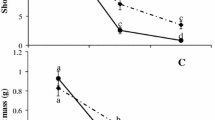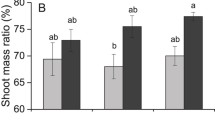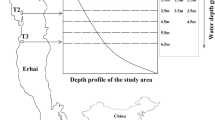Abstract
Zizania latifolia is a common emergent macrophyte that plays an important role in the ecological restoration of lakes in the middle and lower reaches of the Yangtze River basin. To understand the mechanisms behind the relative changes in the distribution of Z. latifolia in the field, we analyzed the effects of water depth and substrate type on rhizome bud sprouting (RBS) and growth in Z. latifolia through simulation experiments. Four water depths (0, 30, 60, and 90 cm) and three substrate types (sandy loam, clay loam, and silt) were used. The results showed that: (1) water depth significantly affected the RBS, and the RBS percentage significantly decreased with increasing water depth. However, substrate type and its interaction with water depth had no effect on RBS. (2) Two-way analysis of variance (ANOVA) showed that plant height, stem diameter, and root length were significantly affected by water depth, with the highest values observed at a water depth of 0 cm. Only root length was significantly affected by substrate type and its interaction with water depth, and it was highest in silt. (3) Both water depth and its interaction with substrate type had significant effects on total biomass and the root:shoot ratio in Z. latifolia, but no significant effect was found when it came to subtrate type. The results of this study will be useful for the ecological restoration of lakes in the middle and lower reaches of the Yangtze River basin.





Similar content being viewed by others
References
Bai X, Chen K, Chen X (2013) Short-time response in growth and sediment properties of Zizania latifolia to water depth. Environ Earth Sci 70:2847–2854
Cao Y (2007) Study on impact factor and technique of vegetation restoration for flood beaches wetlands along Yangtze River. PhD thesis, Nanjing Normal University, Nanjing
Cooling MP, Ganf GG, Walker KF (2001) Leaf recruitment and elongation: an adaptive response to flooding in Villarsia reniformis. Aquatic Bot 70:281–294
Coops H, van den Brink FWB, van der Velde G (1996) Growth and morphological responses of four helophyte species in an experimental water-depth gradient. Aquatic Bot 54:11–24
Coops H, Vulink JT, van Nes EH (2004) Managed water levels and the expansion of emergent vegetation along a lakeshore. Limnologica 34:57–64
Deng ZF, Xie XL, Wang ZS, An SQ (2010) Effects of substrate and water level on the growth of invasive species Spartina alterniflora. Chin J Ecol 29(2):256–260
Fang J, Wang Z, Zhao S, Li Y, Tang Z, Yu D, Ni L, Liu H, Xie P, Da L, Li Z, Zheng C (2006) Biodiversity changes in the lakes of the Central Yangtze. Front Ecol Environ 4(7):369–377
Gu XH, Zhang SZ, Bai XL, Hu WP, Hu YH, Wang XR (2005) Evolution of community structure of aquatic macrophytes in East Taihu Lake and its wetlands. Acta Ecol Sin 25:1541–1548
Jian YX, Wang JB, He GQ, Chen JK (2001) Effects of water depth gradients, matrices, light and removal of plantlets on germination of turions of Potamogeton crispus L. Acta Hydrobiol Sin 25(3):224–229
Kara HB, Yavuz T, Tuncdemir AR, Ozyilmaz OY (2013) Effects of different concentrations of hydrogen peroxide on the color stability of various esthetic restorative materials in vitro. Eur J Prosthodont 1:11–16
Lenssen JPM, Menting FBJ, van der Putten WH, Blom CWPM (1999) Effects of sediment type and water level on biomass production of wetland plant species. Aquatic Bot 64(2):151–165
Li WC (1997) Yellow water in East Taihu Lake caused by Zizania latifolia and its prevention. J Lake Sci 9:364–368
Li EH, Li W, Wang XL, Xue HP, Xiao F (2010) Experiment of emergent macrophytes growing in contaminated sludge: implication for sediment purification and lake restoration. Ecol Eng 36(4):427–434
Lu RS (2000) Soil and agriculture chemical analysis methods. Chinese Agricultural Science and Technology Press, Beijing
Lytle DA, Poff N (2004) Adaption to natural flow regimes. Trends Ecol Evol 19:94–100
Macek P, Rejmánková E, Houdková K (2006) The effect of long-term submergence on functional properties of Eleocharis cellulosa Torr. Aquatic Bot 84:251–258
Mauchamp A, Blanch S, Grillas P (2001) Effects of submergence on the growth of Phragmites australis seedlings. Aquatic Bot 69:147–164
Nishihiro J, Miyawaki S, Fujiwara N, Washitani I (2004) Regeneration failure of lakeshore plants under an artificially altered water regime. Ecol Res 19:613–623
Poff NL, Allan JD, Bain MB, Karr JR, Prestegaard KL, Rigther BD, Sparks RE, Stromberg JC (1997) The natural flow regime: a paradigm for river conservation and restoration. Bioscience 47:769–784
Tian YB, Song GY (2002) Wetland soil and its ecological functions. Chin J Ecol 21(6):36–39
Wang YQ (1991) The biology of Zizania latifolia. In: Research group of Honghu Lake of Chinese Academy of Science, Institute of Hydrobiology (ed). Comprehensive development of biological productivity and ecological optimization of ecological environment in Honghu Lake. China Ocean Press, Beijing, pp 65–67
Wang SM, Dou HS (1998) Lakes of China. Science Press, Beijing
Wang HZ, Wang HJ (2009) Ecological effects of river-lake disconnection and restoration strategies in the midlower Yangtze River. In: Wang ZY (ed) Ecological management on water and sediment in the Yangtze River basin. Science Press, Beijing, pp 379–396
Wang X, Chen XF, Guan BH, Liu ZW (2013) Effects of substrate on Vallisneria natans and Elodea canadensis under cyanobacterial stress conditions. Ecol Sci 32(3):303–307
Wang QL, Chen JR, Liu F, Li W (2014) Morphological changes and resource allocation of Zizania latifolia (Griseb.) Stapf in response to different submergence depth and duration. Flora 209:279–284
Wei FS (2002) Monitoring and analysis method of water and wastewater, 4th edn. China Environmental Science Press, Beijing
Yamasaki S, Tange I (1981) Growth responses of Zizania latifolia, Phragmites australis and Miscanthus sacchariflorus to varying inundation. Aquatic Bot 10:229–239
Zhang XK, Liu XQ, Ding QZ (2013) Morphological responses to water level fluctuations of two submerged macrophytes, Myriophyllum spicatum and Hydrilla verticillata. J Plant Ecol 6:64–70
Zhang XK, Liu XQ, Wang HZ (2014) Developing water level regulation strategies for macrophytes restoration of a large river–disconnected lake, China. Ecol Eng 68:25–31
Zhang XK, Liu XQ, Wang HZ (2015) Effects of water level fluctuations on lakeshore vegetation of three subtropical floodplain lakes, China. Hydrobiologia 747:43–52
Zhang XK, Wan A, Wang HL, Zhu LL, Yin J, Liu ZG, Yu DP (2016) The overgrowth of Zizania latifolia in a subtropical floodplain lake: changes in its distribution and possible water level control measures. Ecol Eng 89:114–120
Acknowledgements
We thank Bao Cheng, Jialei Li, and Feng Tao for their assistance with the experiments. This work was supported by grants from the Natural Science Foundation of Anhui Province (1508085QD75), the National Natural Science Foundation of China (41501028), and the Special Fund for Agro-scientific Research in the Public Interest (201203083).
Author information
Authors and Affiliations
Corresponding author
Rights and permissions
About this article
Cite this article
Li, Z., Zhang, X., Wan, A. et al. Effects of water depth and substrate type on rhizome bud sprouting and growth in Zizania latifolia. Wetlands Ecol Manage 26, 277–284 (2018). https://doi.org/10.1007/s11273-017-9572-9
Received:
Accepted:
Published:
Issue Date:
DOI: https://doi.org/10.1007/s11273-017-9572-9




